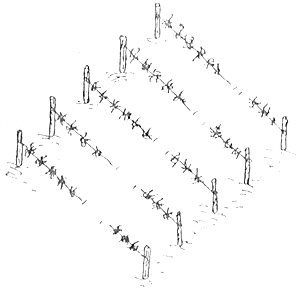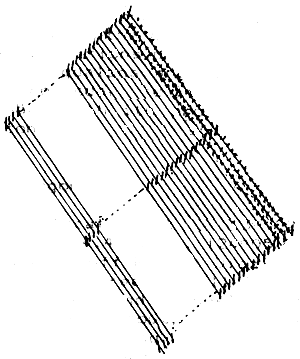Preliminary identification and classification of wild and farmed seaweeds in the project area are being carried out by Dr. Trono, National Biologist Consultant and Ms. Llana, National Project Coordinator. At present over 12 common species of Gracilaria species have been tentatively identified. However, four species namely, G. firma (=G. fisheri), G. fastigiata, G. changii (= G. cylindrica), and G. tenuistipitata, are being used for farming trials (Trono, 1992). Four forms of G. tenuistipitata are recognised in the area. Recently another species, G. salicornia which appears to have good potential is now being under consideration. Field identification of the Gracilaria species used in the trials are shown in plate I (Nyan Taw, 1993).
Major farming trials were carried out along the eastern coastal areas of Prieto Diaz and Gubat in Eastern Sorsogon. In Sorsogon Bay, Juban was the area where farming trials were done. Test plots were setup to determine the feasibility in a number of places both in the east coast and in Sorsogon bay. At the east coast; test plots were set at the municipalities of Barcelona and Bulusan. In Sorsogon Bay a number of test plots were set around the munilicipaties of Magallanes and Castilla. Basically the methods used were either fixed bottom or floating raft system. Pond culture trials were also implemented in Tagdon, Barcelona and in Juban with the cooperation of fishpond operators. The four Gracilaria species were used in accordance with their specific environmental preference.
The fixed bottom monoline method has been used extensively in the farming of Eucheuma in the Philippines. The method was described by Trono and Fortes (1988) and Trono (1988). The monoline method used in farming trials of the Gracilaria species is basically the same to that described by the Authors. The main differences are the type of line used and the way the seed stock are attached to the line. The line used was bi-filament polyethylene twine No. 5 (2.5 mm). A simple 10×10 meter fixed bottom monoline plot is shown in figures 3 and 4. The stakes which were driven deep into the substrata were spaced either 5 or 10 meters apart and at 32 cm interval. A plot was considered as having 32 lines with a length of 5 meters × 2 or 10 meters. In a plot 1,024 seed plants (32×32 plants) were planted. The seed stock cuttings (approximatelly 25 to 50 grams/ plant) were inserted between the twines. In practice the lines stretched 5 meters apart can withstand the weight of farmed seaweed better than line 10 meter apart especially during the final period of farming. The lines were suspended between 30 and 50 cm from the substratum. The lines were positioned parallel to the water current.
The method is also being used in farming of Eucheuma in the Philippines. Comparatively, this type of farming is more expensive than the fixed bottom monoline method. The method was described for farming of Eucheuma by Trono & Fortes (1988) and Trono (1988). Apart from the line used and the method of attaching the the seed stock the floating raft monoline method is basically the same as given by Authors. The type of line and the method of attaching the seed plant were as explained in the fixed bottom monoline method. The size of raft was 2.5× 2.5 Meter (figures 5 and 6). The seaweeds were approximately 30 cm submerged in the water from the surface.
Pond culture method of farming of Gracilaria, specially G. teniustipitata has been extensively used along the southern coast of mainland China and the western coast of Taiwan (Anonymous, 1990). In the Philippines, although Trono & Fortes (1988) and Trono (1988) described the method, apart from some experimental studies, very little is being done. In the present study, attempts are being made in cooperation with fish pond owners to initiate the trials. No special treatment nor management on pond water had been done during the trials.

Fig.2. Monolines with seed plants

Fig. 3. Seed plants in bi-filament

Fig. 4. A fixed bottom monoline plot

Fig. 5. A floating monoline raft